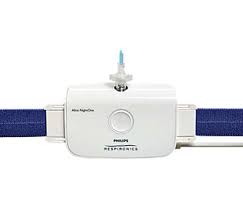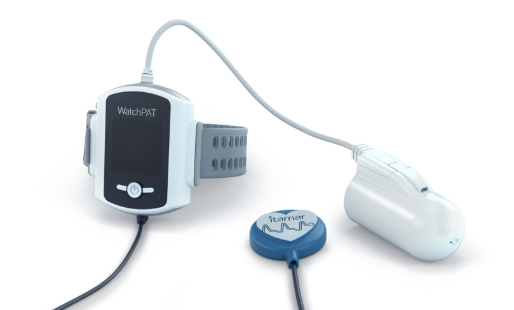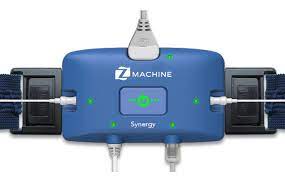Click your Device for an Instructional Video
About the Alice NightOne Device and Sensors
Delaware Sleep Disorder Centers will give you a case with everything you need for your HSAT. The case will include:
- An Alice NightOne device– This device collects and stores all of the data gathered from your night of sleep.
- An effort belt– This is a belt you’ll wear around your chest. It measures your respiratory effort.
- A nasal cannula– This cannula that sits gently under the nose will measure your breathing effort, as well as snoring.
- A pulse oximeter– This is a sensor that you’ll place on your finger. It will measure your pulse, blood flow, and the amount of oxygen in your blood.
- Tape– Tape will be used to secure the pulse oximeter as well as the cannula if needed.
- Batteries. Extra batteries are included in case the unit stops working.
The case will also include a user manual, DVD to assist with setup if needed and additional paperwork if required.
About the Alice NightOne device icons on top of device
The top of the Alice NightOne device has 4 icons that light up to give you information.

- The effort belt, nasal cannula, and pulse oximeter icons.
The effort belt, nasal cannula, and pulse oximeter icons (see Figure 1) tell you about the sensors.
- If these icons are green, it means the sensors are connected and working properly.
- If one of these icons is flashing yellow, it means that sensor needs to be connected or adjusted. It may take a few seconds for the icon to change from yellow to green after you connect or adjust a sensor.

- The good study indicator
- The good study indicator (above) can tell you how how much of the data from your HSAT is good quality. It also tells you when the Alice NightOne device is turning on or off. The 4 parts of the good study indicator can light up separately.
- About the user button
- The user button is the round button on the front of the Alice NightOne device. Only use after the study is completed.
- End your HSAT and show the good study indicator. You can do this in the morning to check how much good quality data was collected. For more information about this, read the section “Checking the data quality” near the end of this resource.
- How to Put On the Sensors
- Wear a loose-fitting top (such as a t-shirt) on the night of your HSAT. Once you’re ready for bed, put the sensors on as directed below. Put them on while you’re standing or sitting up, not lying down
Effort belt
- Wrap the effort belt around your chest so the Alice NightOne device is in the centered on your chest (see below). The effort belt should be evenly across your sternum. The belt should be snug but not too tight.
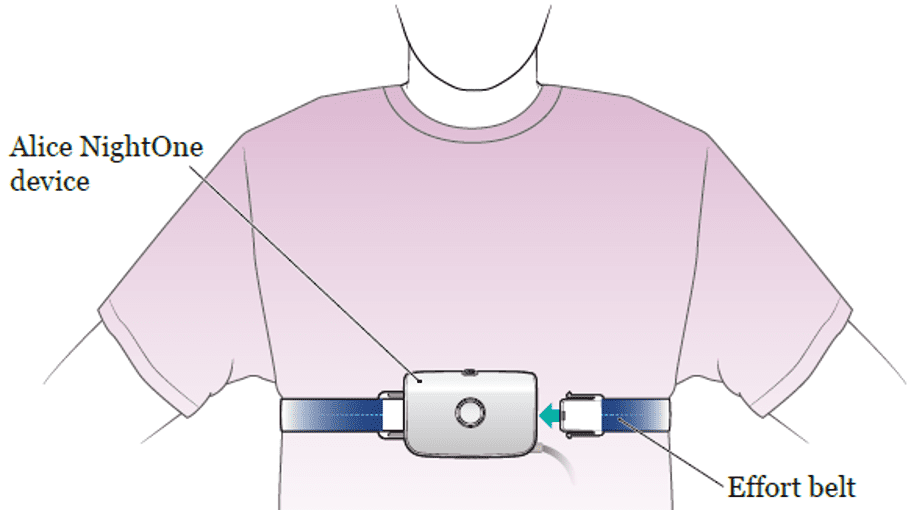
- Effort belt around your chest
- Plug the ends of the effort belt into the Alice NightOne device (see Figure 3). After the effort belt is connected, the good study indicator will blink green as the device automatically turns on and starts recording.
- Once the device is turned on, the effort belt icon will appear. It will probably be flashing yellow. Use the buckle on the effort belt to adjust the belt so it’s snug but not uncomfortable (see below).

- Use the buckle to adjust the effort belt
Once the effort belt icon turns green, put on the nasal cannula. The nasal cannula icon will appear to remind you.
Nasal cannula
- Twist the cannula clockwise (to the right) to connect it to the top of the Alice NightOne device (see below).

- Connect the nasal cannula
- Hold the nasal cannula tube in front of your face. Check that the prongs on the tube curve slightly inward toward you. Then, gently place the prongs into your nose (see below). One prong should go into each nostril.
- Loop the nasal cannula tube over each of your ears and under your chin. Move the slider on the tube up so the tube is snug under your chin (see below)
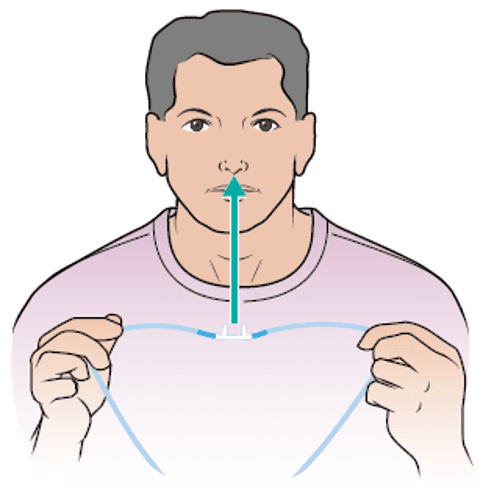
- Place the nasal cannula prongs into your nose
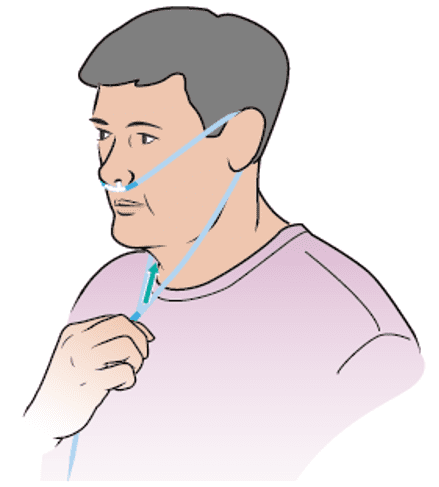
- Loop the tube over your ears and adjust the slider
- Take several breaths with the nasal cannula in place. The nasal cannula icon on the device should turn green.
Once the nasal cannula icon turns green, put on the pulse oximeter. The pulse oximeter icon will appear to remind you.
Pulse oximeter
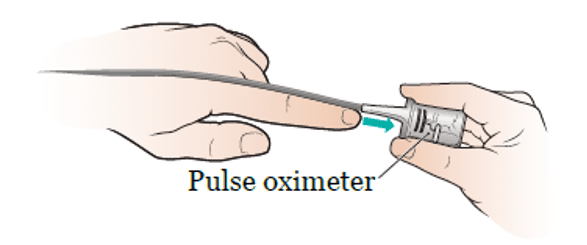
- Put the pulse oximeter on your finger
Put the rubber sensor on one of your index fingers (see above)
- The pulse oximeter only works on a natural, clean nail. If you have fake nails or are wearing nail polish, take it off before putting the pulse oximeter on.
- Place the sensor so the wire goes over the back of your hand.
- Use the tape right above the knuckle to ensure the pulse oximeter stays in place throughout the night.
The pulse oximeter icon should turn green.
- How to Start Your HSAT
Once all the sensors are connected and working properly, the 3 sensor icons and the good study indicator will be solid green. After about a minute, the icons will start to turn off one by one. Once all the icons have turned off, the Alice NightOne device is ready. You may now go to sleep.
You can sleep in your usual position (such as on your back, side, or stomach) during your HSAT. Leave the Alice NightOne device and sensors on all night, even if you get up to use the restroom or for any other reason. If any of the sensors slip off or move during the night, put them back on. You don’t need to stop your HSAT.
- How to End Your HSAT
To end your HSAT, take off the sensors and disconnect them from the Alice NightOne device. The device will turn off automatically.
- Checking the data quality
You can check how much good quality data the Alice NightOne device collected during your HSAT. Only do this in the morning after you finish your HSAT. Follow the instructions below.
- Press and hold the user button until the good study indicator flashes. This means the device is no longer recording.
- Wait at least 1 minute.
- Briefly (for fewer than 5 seconds) press the user button. Then, release the user button. The good study indicator will be displayed on top of the Alice NightOne device.
- If all 4 parts of the good study indicator are green, 100% of the data collected is good quality.

- If 3 parts of the good study indicator are green, 75% of the data collected is good quality.

- If 2 parts of the good study indicator are green, 50% of the data collected is good quality.

- If only 1 part of the good study indicator is green, 25% of the data collected is good quality.

- If both nights have only 1 part of good study indicator, please call office for more instructions.

